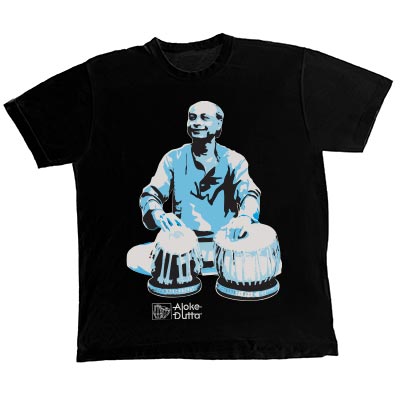Theme variation or vistara (Indian language) in tabla composition is quite unique. The rules are very strict, but this rigidity helps students and players to stay focused on a single emotion, while expanding a specific composition. There are two primary rules. First, we are not allowed to use a syllable that is not in the main theme. Second, we can alter time signatures, but only for the entire composition. For example, we are allowed to play the composition at its double, triple, or quadruple speeds, but not a combination of different speeds.
These variations are composed by me. At the beginning we memorize the variations and practice them hard for several years. Eventually, we develop our own ability to improvise, just like the way we learn a foreign language.
I wrote the main theme in single speed in my last post. Here, I have written its double, triple and quadruple speeds, and the remaining variations will be written at quadruple speed. Ultimately, this composition will be performed at quadruple speed. I will use two claps per line instead of four, because density of notes will increase by two/three/four times. I have also reduced the font size at quadruple speed. Please make a note that phrases are sometimes going over the bar lines depending on the speed. I like to label variations in alphabetical orders (a, b, c…).

In this type of composition, we improvise, or expand upon a main theme. I call it a Heroic Journey, but, this is not my composition. This comes from Farukhabad school of tabla playing. The temperament of this particular composition is “I am here to win it”. Phrases are primarily in 4, except for the end phrases of the second and fourth lines which are in 6. The time signature is 4/4, and the whole composition is set to 16-beat time cycle or tintala.
Improvisational tabla compositions have two major parts. I call them male and female from the old Hindu concept of purusha and prakriti of Sankhya Philosophy. This concept of dualism is very Eastern. It is also present in Chinese philosophy as yin and yang.
The following composition is divided right in the middle. First two lines are male and last two lines are its female counter part. Next, each male and female parts are subdivided in identical process. These subdivisions add up to 8 and 8+8 is 16. In this composition, 8 is divided as 5+3. Further division is now required to see the anatomy of the rhythm of the whole. 5 is divided as 1+1+1+1+1, where each 1 has 4 notes. 3 is 1½ + 1½. Each 1½ phrase has 6 notes.
This kind of mathematical phrase arrangement expresses heroic mood. Character of notes used are also important, however, if the theme with its specific meaning is clear in composer’s heart then the notes simply pop up in mind to articulate his/her thoughts. We, students of music, then practice maestro’s creations diligently to improve our understanding of the deeper meaning of abstract sounds.

Parentheses are used to mark the phrases. I am assuming that tabla students know how to produce these notes and the meaning of the numbers ( 2, 1) written underneath. Non-tabla people simply ignore those numbers. | – vertical line is the symbol of metronomic beat. We clap on those lines. – indicates ¼ note rest. The notes in the composition are easy to pronounce for everybody. To grasp the composition rhythmically, clap at metronomic speed 30 and recite the composition the way it is written. We will call it single speed. If for some reason clapping at 30 seems difficult then clap at 60. In that case recite two notes per clap.

In the next few weeks Aloke will begin posting compositions on his website that have not been published in any of his books. It is quite possible that these have never been documented in any tabla book, in any language! He will be describing these compositions technically and mathematically in terms that can be understood by musicians of any discipline. Please check back soon!

 Aloke Dutta
Aloke Dutta



